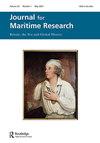“杀死信天翁是不吉利的”:20世纪30年代芬兰帆船上象征自由的海洋动物
Q3 Arts and Humanities
引用次数: 0
摘要
本文探讨了二十世纪初芬兰深海帆船上野生海洋动物与人类的邂逅。当时,帆船正在从世界的海洋中消失,20世纪30年代的深海水手们把自己浪漫地想象成世界上最后一批狂野而自由的冒险家。海洋动物在这种浪漫化中扮演了核心角色,因此与它们的相遇变得高度仪式化。本文以航海家温妮弗雷德·劳埃德(Winifred Lloyd, 1897-1940)的航海日记和当时的其他航海记录为依据,认为信天翁体现了航海冒险的魅力,水手与海洋的英勇相遇,以及帆船作为男性同族和自由的空间。因此,它们成为正在消失的海洋生物和社区的象征,而信天翁的尸体,往往被水手捕获并杀害,也证明了人类对自然的剥削是海洋历史的重要组成部分。本文章由计算机程序翻译,如有差异,请以英文原文为准。
‘To kill an albatross is unlucky’: maritime animals as symbols of freedom on Finnish windjammers in the 1930s
ABSTRACT This article explores encounters between wild maritime animals and humans on Finnish deep-sea sailing ships in the early twentieth century. At that time, sailing ships were disappearing from the world’s oceans, and the deep-sea sailors of the 1930s romanticised themselves as representing the last wild and free adventurers in the world. Maritime animals played a central role in this romanticisation, and the encounters with them therefore came to be highly ritualised. Drawing on sailmaker Winifred Lloyd’s (1897–1940) diaries and other maritime accounts of that time which contain rich textual and visual evidence, this article argues that the albatross embodied the glamour of maritime adventures, the heroic meeting between sailors and the ocean, and the sailing ship as a space of masculine homosociality and freedom. As such, they became symbols of the vanishing maritime life and community, while the bodies of albatrosses, caught and often killed by the sailors, bear witness also to the fact that the human exploitation of nature is an important part of maritime history.
求助全文
通过发布文献求助,成功后即可免费获取论文全文。
去求助
来源期刊

Journal for Maritime Research
Arts and Humanities-History
自引率
0.00%
发文量
0
期刊介绍:
The Journal for Maritime Research ( JMR ), established by the National Maritime Museum in 1999, focuses on historical enquiry at the intersections of maritime, British and global history. It champions a wide spectrum of innovative research on the maritime past. While the Journal has a particular focus on the British experience, it positions this within broad oceanic and international contexts, encouraging comparative perspectives and interdisciplinary approaches. The journal publishes research essays and reviews around 15-20 new books each year across a broad spectrum of maritime history. All research articles published in this journal undergo rigorous peer review, involving initial editor screening and independent assessment, normally by two anonymous referees.
 求助内容:
求助内容: 应助结果提醒方式:
应助结果提醒方式:


